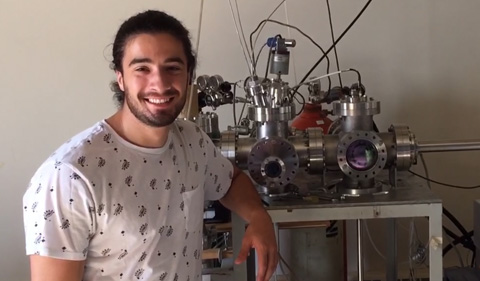By Zak Blumer ’18
B.S. Engineering Physics, Honors Tutorial College
During most of my childhood, my father served as the director of The Wilds—one of the largest wildlife conservation centers in North America. Living in eastern Ohio, I was surrounded by nature and wildlife, and consequently grew up with a passion to protect our planet. As I grew older, I became captivated by the concept of renewable energy—it combines my lifelong connection to the environment and my enthusiasm for science.
When I began formulating my undergraduate research topic, I knew I wanted a focus in solar energy. It wasn’t until I did solar policy research at OHIO’s Voinovich School of Public Leadership & Affairs that I noticed the tremendous gap between how much research and development funding is directed toward photovoltaic research versus solar thermal research. Once I saw this, I decided to focus on solar thermal technologies.
Solar energy can be captured by photovoltaics and solar thermal methods. In photovoltaics, solar cells make use of the photoelectric effect to convert light directly into electricity. In solar thermal technologies, however, light is converted directly to heat. This is what happens when a black shirt feels hotter than a white one on a sunny day. My research focuses on this type of solar energy technology.
I want to understand more about the processes by which solar thermal energy is generated. Specifically, I am interested in determining the potential for a certain material (titanium nitride) to be used in solar thermal technology. To do so, I spend time analyzing the optical properties of this material in various structural forms.
Typically, solar thermal energy is captured by use of mirrors and lenses. But concentrating solar power incurs a high materials cost thus rendering it extremely under-developed as an energy generation technology. Titanium nitride, with its much lower cost and better durability, could prove to be a stepping stone on the way to eliminating the need for mirrors and lenses altogether.
Evacuated tube solar collectors are another common method for heating a home’s water. These tubes use a film with embedded nanoparticles to achieve such a great heating efficiency. TiN could potentially improve this film or make it less costly, as well.
As part of my internship and continued research, I’ve learned valuable skills from Dr. Martin Kordesch, a professor in Physics and Astronomy. He’s taught me how to perform DC/RF sputter deposition, scanning electron microscopy (SEM), X-ray diffraction (XRD), energy-dispersive spectroscopy (EDS), electrospinning, and general machining.
Dr. Kordesch provided me with the physics-based guidance. I have also worked closely with Dr. Hugh H. Richardson, a professor in Chemistry and Biochemistry. He provided chemistry-based guidance and helped me better understand optical microscopy, Raman spectroscopy, photoluminescence (PL) spectroscopy, and many more optical phenomena. I worked in Dr. Richardson’s lab to begin electrospinning.
This coming April I have an opportunity to present some of my research at the 2018 Materials Research Society (MRS) Spring Meeting & Exhibit taking place in Phoenix, Arizona.




















One Comment